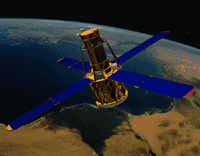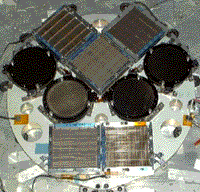|

|

|
NEWS SEARCH
|
|
|
|

|
UC
Berkeley/NASA launch HESSI satellite, continued:
The
HESSI mission
31
January 2002
 |
| Rendering
of HESSI spacecraft in orbit around Earth. Hi-res
version. Spectrum Astro Inc. graphic |
HESSI
is the first Small Explorer (SMEX) spacecraft to be managed in a way
that gives the principal investigator — in this case, Robert P.
Lin — responsibility for most aspects of the mission. This includes
not only the scientific instrument but also the spacecraft, integration,
all environmental testing, and operations and data analysis after launch.
The Explorers Program Office at Goddard provides management and technical
oversight for the HESSI mission under the direction of the Office of
Space Science at NASA headquarters in Washington, D.C.
-
UC
Berkeley scientists built the spectrometer with its germanium
detectors and data processing electronics;
-
The
Paul Scherrer Institut in Switzerland provided the imaging
telescope and optical aspect system.
-
Goddard
Space Flight Center provided the grids and the cryocooler
and supported the alignment of the imaging telescope.
-
Spectrum
Astro Inc., of Phoenix, Ariz., provided the spacecraft
electronics, the satellite skeleton (called the spacecraft
bus) and integration support.
-
Tecomet, a subsidiary of Thermo Electron, Inc., Waltham,
Mass., and van Beek Consultancy, The Netherlands, supplied
the tungsten and molybdenum imaging grids for the instrument.
Tecomet used new microfabrication techniques to create
slits in the grids as narrow as 20 microns — less
than one thousandth of an inch.
-
 |
| One
of HESSI's two grid trays. The nine pairs of grids
collimate X-rays and gamma rays to produce pictures
of solar flares. NASA photo |
The
ORTEC division of PerkinElmer Instruments provided the
largest and most advanced array of germanium detectors
ever flown in space. The nine germanium crystals, one
under each pair of grids, were artificially grown to be
pure to over one part in a trillion. They are maintained
at a temperature of -324 degrees Fahrenheit (-198 Celsius)
using a new type of mechanical cooler manufactured by
Sunpower, Inc., that has never before been flown in space.
HESSI
links:
UC Berkeley:
http://hessi.ssl.berkeley.edu/
Goddard
Space Flight Center: http://hesperia.gsfc.nasa.gov/hessi/
Paul Scherrer
Institut: http://hessi.web.psi.ch/
Spectrum
Astro Inc.: http://www.specastro.com/ProgramsProducts/Hessi.asp
NASA's
HESSI press kit: http://pao.gsfc.nasa.gov/gsfc/newsroom/pkits/pkits.htm
HESSI education
and public outreach site: http://cse.ssl.berkeley.edu/hessi_epo/
<<
previous
|

|